
NPS Photo Featured Friends
NPS Photo Spotted SalamanderAmbystoma maculatum You may know that salamanders have the ability to drop and regrow their tails when evading predators, but the Spotted Salamander goes a step further. These small amphibians can re-grow their tail, legs, internal organs, even parts of their head and brain! When the Spotted Salamander is in full position of all its pieces, it measures 6-10 inches in length. You can identify them not by color because they may be black, brown or gray, but by their distinctive yellow spots. Those spots act as a warning to predator- “Hey, try to eat me and I will release a toxic poison that will make you super sick!” This strategy must work well, as the average life span for a spotted salamander is 20 to 30 years. They live these long lives in hardwood and mixed forests and prefer to live near swamps and vernal pools where food is plentiful. They eat insects, snails, spiders, small invertebrates and lots of mosquitos! Because Spotted Salamanders stay very close to their nesting and feeding area, they are very sensitive to changes in the environment and can act as an indicator species for specific ecosystems. 
NPS Photo American ToadAnaxyrus (Bufo) Americana The American Toad is a frequent visitor to the Battle Road Trail. It can live most anywhere in the park, so long as there is some moist soil, a place to burrow, lots of bugs, and good hiding spots. The American Toad does secrete a toxic enzyme from glands on the skin (yes, it is toxic to humans, so don’t pick them up!) or puff itself up to look big and intimidating, but it prefers simply to hide and use its natural camouflage. This toad may be tan, brown, red or green with some patterning and a light stripe down the back. Adding to the toads earthy, dirt pile look is warty skin with two large warts behind the head. This camouflage in coordination with burrowing skills is what allows the American Toad to hibernate through winter. It will only do this once or twice as the toad lives just 1 to 2 years. It will also mate once or twice in the spring. Males attract the female with a high-pitched trilling song that lasts up to 30 minutes. When the female arrives, the male hugs her till she releases 2,000-20,000 eggs, which he then fertilizes. 
NPS Photo Spring PeeperPseudacris crucifer You will likely hear these tiny frogs, but never see them. The Spring Peeper is just an inch long and weighs less than an ounce. The peeper is tan with dark lines than form an x on their back, which allows them to hide in leaves and ground debris in wetland areas and forest vernal pools. Additionally, they hibernate all winter and are nocturnal in summer. Despite all that, peepers are a large part of the Minute Man soundscape. Their bell like peeps signify the onset of spring. Each frog will peep up to 20 times per min. The louder and faster a male peeps, the more likely he is to attract a lady peeper. The males sing as a group with the bass in the chorus starting the call. As you can imagine, these spring concerts are quite loud and can be heard from as far away as 2 miles! 
NPS Photo Wood FrogLithobates (R) sylvatica Without question, the Wood Frog is the coolest frog, not just at Minute Man, but we would contend, anywhere. This small masked amphibian freezes solid in winter (see? cool)! During this deep hibernation, the Wood Frog stops breathing and its heart stops beating… yep, you read that correctly. It has no pulse and no respiration! Even the lenses of their eyes freeze and turn white. So how does this species survive in this state for months? Sugar. Due to a hyper production of glucose from the liver during late summer and early fall, the frog’s blood sugar is so high, the blood itself can’t freeze. This unique adaptation, which allows the frog to tolerate blood sugar levels well beyond what is tolerable in humans, is something scientists and researchers are investigating for the potential implications in treating diabetes. You can find Wood Frogs from Alaska to Alabama to Maine. In fact, they are the only frogs that live north of the arctic circle. In Massachusetts, the Wood Frog likes mixed forests with vernal pools. When walking past these pools during spring mating season, you’ll hear a cacophony of loud quack-like croaking day or night. One more fun fact about Wood Frogs is they can recognize family. Tadpoles seek out their siblings in the pools where they’re born. 
NPS Photo Common Snapping TurtleChelydra serpentaria We see Snapping Turtles by the North Bridge and near the Buttrick Gardens regularly. Sometimes they are tiny and sweet like this baby snapper, others, are 2 feet long, 35 pounds and angry. But please don’t misunderstand, Snapping Turtles are not aggressive. They are actually quite curious, and if not familiar with humans, may investigate or even bump you with its nose. Snapping turtles earn their name when they feel threatened. They have a very flexible neck and can bite an attacker from most angles. Some humans will try to avoid this by grabbing a snapping turtle by the tail, but this is likely to injure the animal’s spine or even kill it, so best to just let them plod along on their way. In addition to that long neck, beak-like mouth, and long tail, you may recognize a Snapping Turtle by its rocky shell and big claws. This turtle is omnivorous, eating plants, fish, frogs, invertebrates, and maybe a duckling. Average lifespan is not known but, is more than 100 years and maybe as many as 170 years. 
NPS Photo/ Gordon Dietzman Blanding's TurtleEmydoidea blandingi If there is a turtle that looks most like the one you drew in elementary school, it’s the Blanding’s Turtle. Measuring 7 to 10 inches long, with a curved bell-shaped shell, and a bright yellow chin, it’s a pretty distinctive and cartoonish turtle. Unfortunately, life has not been easy for this little reptile. The Blanding’s is listed as an endangered species in most of its range in the upper mid-west, as well as the discrete population areas in New England. An active conservation working group was formed in the northern New England state in order to address the steep declines in numbers and there have been several recent turtle releases to help boost population. Why are they in trouble? There are a few factors at play. They don’t begin mating till age 14 to 20 and there’s low reproductive success. Loss of habitat, predation, poaching, and other sources of adult mortality are also impactful to the population. If able, a Blanding’s Turtle may live up to 70 years in the wild. 
NPS Photo Eastern Garter SnakeThamnophis sirtalis Let us introduce the honorable, but humble, state reptile of Massachusetts. The Eastern Garter Snake is relatively small, measuring just over 3 feet on average and weighing about a pound. The Eastern Garter Snake is a sub-species of the Common Garter Snake, which is, you guessed it the most common and widely distributed reptile in the US. There are many species of Garter snakes, maybe as many as 35, most with distinctive red or yellow stripes on a dark body. None are venomous, but they are carnivorous, eating frogs, salamanders, fish, and eggs. These snakes live in woodlands with lots of water and are both good climbers and good swimmers. One unique thing about the garter snake is that is ovoviviparous, meaning it keeps its eggs inside its body and gives “live” birth, rather than nesting. The babies don’t need any mothering and they don’t get it, being independent from birth. 
NPS Photo Northern Water SnakeNatrix sipedon The Northern Water Snake has a wide head and dark rings which causes people mistake them for copperheads or cottonmouths. Despite not being venomous, the resemblance means water snakes are often killed by humans who fear them. The Northern Water Snake measures 2-4 feet long and may be brown, gray or green. They live in areas with still or slow water like ponds and vernal pools where they find plentiful food, including fish, frogs, salamanders, and birds, which they swallow whole. Water snakes will cuddle or coil together when the weather is cool, but go solo once the weather heats up. Females give birth in late summer through early fall, hatching 8-12 snakelets. Like the garter snake, the babies don’t need mama and are immediately independent. Like many northern snakes, it hibernates in winter. The Eastern Water Snake lives 9 to 10 years on average. Reptiles and Amphibian Links and Lists
Learn more about natural resources at Minute Man by visiting the Northeast Temperate Inventory & Monitoring website. Minute Man is a designated place with multiple projects on iNaturalist, an on-line citizen science database. Help the park track all wild species (mammals, bird, insects, plants, etc.) and behavior by adding your observations to iNaturalist whenever you visit. To learn more about non-NPS citizen science initiatives, check out this article from the National Park Service. |
Last updated: December 9, 2021
